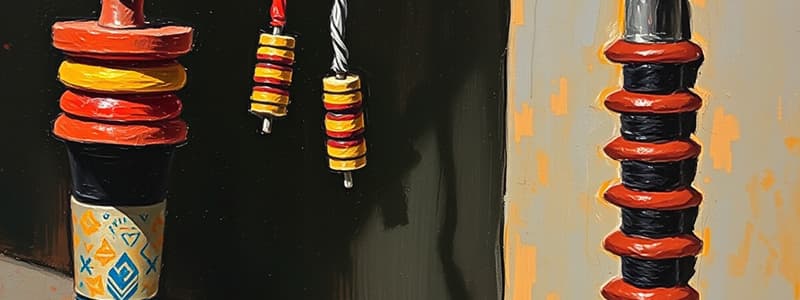Podcast
Questions and Answers
What is voltage?
What is voltage?
Energy per unit of charge
What is electrical current?
What is electrical current?
Rate of flow of charge
What is resistance?
What is resistance?
Opposition to current
An ideal current source can provide a constant current in any load.
An ideal current source can provide a constant current in any load.
What are resistors designed to do?
What are resistors designed to do?
Which type of resistor allows its resistance value to be changed easily?
Which type of resistor allows its resistance value to be changed easily?
What is the purpose of a fuse in an electrical circuit?
What is the purpose of a fuse in an electrical circuit?
What does a capacitor do?
What does a capacitor do?
A voltage source provides electrical energy or electromotive force (emf), commonly known as _____
A voltage source provides electrical energy or electromotive force (emf), commonly known as _____
Match the following switch types with their descriptions:
Match the following switch types with their descriptions:
Flashcards are hidden until you start studying
Study Notes
Electrical Fundamentals
- Voltage (V): Energy per unit of charge (measured in volts).
- Current (A): Rate of flow of charge through a conductor (measured in amperes).
- Resistance (Ω): Opposition to the flow of current (measured in ohms).
Voltage and Current Sources
- Voltage Source: Provides electrical energy or electromotive force (emf), can be DC or AC.
- Current Source: Can deliver a constant current regardless of load, ideal current sources are theoretical but approximated in practice.
Resistors
- Purpose: Designed to have specific resistance values to limit current, divide voltage, or generate heat.
- Types of Resistors:
- Variable Resistors: Adjust resistance easily, including potentiometers and rheostats.
- Sensors: Thermistors (temperature-sensitive), Photoconductive cells (light-sensitive), Strain gauges (force-sensitive).
Switches
- Function: Control the opening or closing of circuits.
- Types:
- SPST (Single Pole Single Throw): Controls one circuit.
- SPDT (Single Pole Double Throw): Single pole with two output options.
- DPST (Double Pole Single Throw): Simultaneously controls two sets of contacts.
- DPDT (Double Pole Double Throw): Allows connection between one set of contacts and two others.
- NOPB (Normally Open Push-Button): Connection made only when button is pressed.
- NCPB (Normally Closed Push-Button): Connection broken when button is pressed.
- Rotary Switch: Connection made by turning a knob to one of multiple contacts.
Protective Devices
- Fuses and Circuit Breakers: Create an open circuit when current exceeds a specified level to prevent damage.
- Symbols: Specific symbols represent fuses and circuit breakers in schematics.
Grounding in Circuits
- Ground: Reference point in an electric circuit, can be Reference Ground or Chassis Ground, with designated symbols for representation.
Capacitors
- Definition: Passive electrical components that store electrical charge, characterized by capacitance.
- Construction: Composed of two parallel conductive plates separated by a dielectric material.
- Types: Includes basic, electrolytic, and variable capacitors.
Studying That Suits You
Use AI to generate personalized quizzes and flashcards to suit your learning preferences.




